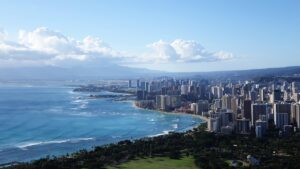The Bond Between Hawaii and Japan: A 150-Year Bridge of Culture
Over 1.5 million Japanese tourists visit Hawaii annually, but our deep affinity for these islands stems from more than just their natural beauty—it's rooted in over 150 years of shared history. Today, we explore the remarkable historical bond between Hawaii and Japan.
The Beginning: 1868 and the "Gannen-mono"

The formal relationship between Japan and Hawaii began in 1868 (the first year of the Meiji era), when 153 Japanese individuals made the first organized journey to Hawaii. Known as "Gannen-mono" (first-year people), these pioneers traveled with permission from the Tokugawa Shogunate to work on sugarcane plantations.
King Kalākaua's Visit and the Start of Contract Immigration
In 1881, King Kalākaua, the seventh monarch of the Kingdom of Hawaii, visited Japan during his world tour and met with Emperor Meiji. During this historic encounter, King Kalākaua formally requested Japanese immigration to Hawaii.
Four years later, in 1885, the "Kanyaku Imin" (government-contract immigration) officially began under the Meiji government's approval. In February, approximately 945 immigrants arrived in Honolulu aboard the City of Tokyo, and by 1894, over 29,000 Japanese had settled on sugar plantations across the Hawaiian Islands.
Waves of Immigration: From Free to Family-Sponsored Migration
From 1900 to 1907, the era of "free immigration" saw approximately 71,000 Japanese migrate to Hawaii. This was followed by the "family-sponsored immigration" period from 1908 to 1924, during which another 61,000 arrived. In total, approximately 220,000 Japanese immigrated to Hawaii during these waves.
This era also witnessed the fascinating phenomenon of "Picture Brides." Men who had immigrated sought to start families by exchanging just a single photograph with prospective brides in Japan. In an age before easy air travel, countless women crossed the Pacific based solely on a photograph, embarking on entirely new lives.
Japanese Contributions That Transformed Hawaiian Society

By 1902, Japanese immigrants comprised 70% of sugarcane plantation workers, and by 1920, Japanese Americans represented a significant portion of Hawaii Territory's population. Japanese immigrants became far more than just laborers—they profoundly influenced Hawaiian society and economy.
Remarkably, many items now considered Hawaiian staples—macadamia nuts, Aloha shirts, and loco moco—were all brought to or created by Japanese immigrants.
Japanese Culture Taking Root

Today, Japanese cultural influence remains vibrant throughout Hawaii.
Japanese Gardens and Architecture
- Liliuokalani Gardens (Hilo): Opened in 1919 as a public garden commemorating Japanese immigrants. It features a red taiko bridge, stone lanterns, torii gates, garden stones, and black pine trees, along with the Shoroan tea house donated by the 15th Grand Master of the Urasenke tea school. The garden was even featured on a U.S. landmark postage stamp series.
- University of Hawaii at Manoa Japanese Garden: A authentic Japanese garden exists on the university campus.
The Permeation of Japanese Food Culture
Hawaii boasts over 300 Japanese restaurants, and words like sukiyaki, shabu-shabu, teriyaki, bento, and shoyu have become so ingrained that they're used as-is in English. Classic menu items including sushi, ramen, tempura, curry, okonomiyaki, tonkatsu, and oden are widely available.
Overcoming Adversity: Pearl Harbor and Beyond
The December 1941 attack on Pearl Harbor brought tremendous challenges to Hawaii's Japanese American community. However, Hawaii-born Nisei (second generation) proved their American identity by volunteering for military service in remarkable numbers.
After the war, returning Japanese American veterans utilized the GI Bill to pursue higher education, becoming politicians, lawyers, doctors, educators, and business leaders who played crucial roles in supporting Hawaii when it became the 50th state in 1959.
Japanese Cultural Center of Hawaii

Photo: Hawaiian Beach Rentals
Today, the Japanese Cultural Center of Hawaii in Honolulu preserves invaluable materials related to Japanese Americans in Hawaii. Here, visitors can learn about the impact Japanese immigrants had on Hawaiian society and the cultural heritage passed down through generations.
What We Inherit
Over 150 years ago, Japanese immigrants who ventured to a land of unfamiliar language and culture laid the foundation for today's deep bond between Hawaii and Japan through their courage and perseverance. What began as a story of arduous labor on sugarcane plantations has evolved into a beautiful relationship where both cultures harmoniously blend.
When we discover Japanese-language signs in Hawaii, feel comforted in a Japanese restaurant, or experience the warm hospitality of Hawaiian people—we're witnessing the cultural bridge built by our predecessors.
At our company, we cherish these historical connections while working to deepen the cultural exchange between Hawaii and Japan. By promoting traditional Japanese culture, including ikebana (Japanese flower arrangement), in Hawaii, we aim to write new chapters in the story for the next 150 years.
References:
- Hawaii Tourism Authority Official Learning Site "History of Japanese Immigration"
- Hawaii Tourism Authority Official Japanese Site "History of Japanese Immigration to Hawaii"
- Hawaii Tourism Authority Official Learning Site "Gannen-mono and Contract Immigration"
- National Diet Library "100 Years of Brazilian Immigration"
- Go Hawaii Official Site "History of Hawaii"
- Meiji-mura Meiji no Oto "The Vitality and Business Acumen of Japanese Immigrants Who Greatly Changed Hawaiian Society and Culture"
- Hawaii Tourism Authority Official Learning Site "Japanese Cultural Center of Hawaii"
